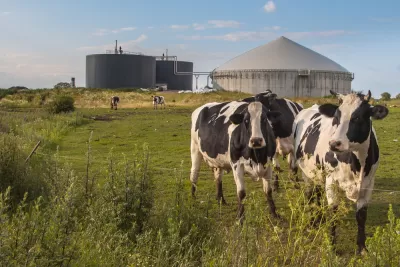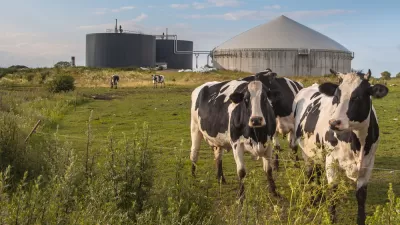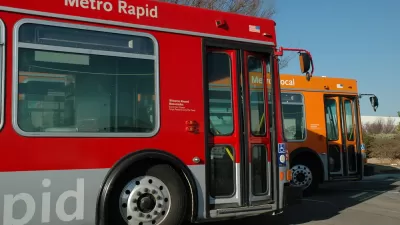Unlike Europe where renewable energy is heavily subsidized, very few biogas projects that convert farm waste to energy using anaerobic digesters are being built in the U.S. State incentives are instrumental due to high capital and maintenance costs.

The initial focus of the article is a 61-year-old dairy farmer in Wisconsin, Art Thelen. He and many other dairy farmers, have "recently have shut down their manure-to-energy systems—known as anaerobic digesters—or scrapped plans to build them because of the prolonged slump in natural-gas prices and higher-than-expected maintenance costs that made the systems less economical," writes Wall Street Journal reporter David L. Kesmodel.
"About 260 digester projects were active or under construction on U.S. farms as of May 2015, according to data compiled by the Environmental Protection Agency from voluntary sources," adds Kesmodel. "Only six new projects became operational or were under construction in 2014, down from an average of about 30 a year from 2008 to 2013."
The potential for these renewable facilities is huge, "8,000 livestock operations are candidates to support biogas projects," according to a 2014 Planetizen post.
While methane emissions "has long drawn criticism of the agriculture industry from environmentalists," wrote Wall Street Journal agricultural commodities reporter, Kelsey Gee, in 2014, "the White House's proposals for curbing gas emitted by livestock rely strictly on voluntary measures that are largely already under way and are focused primarily on the dairy sector."
Germany has more than 8,000 digesters, thanks to a law guaranteeing renewable-energy producers above-market rates for their power for years. China, France, and Denmark also encourage the use of farm digesters.
Nevertheless, installations are expected to pick up in New York, California and a few other states thanks to state government financial incentives, said Melissa VanOrnum, vice president of marketing at DVO Inc., a digester provider. [E.g., see "Anaerobic Digester Generates California Carbon Offsets" by The Climate Trust.]
"And by diverting waste from open-air lagoons, digesters limit the potential for spills that can pollute waterways," adds Kesmodel. Steven Estes, founder/CEO of Star Energy Holdings, a renewable and alternative energy development company based in Fort Wayne, Indiana, elaborated on that benefit in a comment below the article:
The ability of AD [anaerobic digester] facilities to take out the harmful items that cause Algae blooms [sic] - Grand Lake St. Mary's in Ohio, or the Chesapeake watershed that goes across 6 state? What is the prevention of Algae blooms [sic] value? what about the neighbors that no longer have to deal with odor?
And don't forget one of the most important benefits—reduction of methane gas, "the second most prevalent greenhouse gas emitted in the United States from human activities," according to the EPA. "Agriculture accounts for 36% of human-related emissions of methane—a potent heat-trapping gas—in the U.S., making it the biggest source, according to the White House," writes Kesmodal.
The biogas from digesters, mostly composed of methane, can be burned to produce electricity or cleaned and pressurized for transport in natural-gas pipelines. The digestion process also yields products like fertilizer that farmers can use or sell.
They can also be treated and used for a transportation fuel for vehicles that burn natural gas. The city of San Mateo, California has embarked on such a project, using a digester in their wastewater treatment plant. More often the biogas is used for electricity, like the District of Columbia wastewater treatment plant's facility. The province of Ontario, Canada, has been using biogas from cow waste to generate electricity since 2008.
It's not just biogas that is suffering in the low-priced natural gas environment, but fossil gas as well. NPR reports on unemployment affecting the Marcellus Shale drilling region in Pennsylvania.
Hat tip to Ed Mainland, Sierra Club California Energy & Climate Committee
FULL STORY: Energy Prices Steer Farmers Away From Manure Power

Planetizen Federal Action Tracker
A weekly monitor of how Trump’s orders and actions are impacting planners and planning in America.

Chicago’s Ghost Rails
Just beneath the surface of the modern city lie the remnants of its expansive early 20th-century streetcar system.

San Antonio and Austin are Fusing Into one Massive Megaregion
The region spanning the two central Texas cities is growing fast, posing challenges for local infrastructure and water supplies.

Since Zion's Shuttles Went Electric “The Smog is Gone”
Visitors to Zion National Park can enjoy the canyon via the nation’s first fully electric park shuttle system.

Trump Distributing DOT Safety Funds at 1/10 Rate of Biden
Funds for Safe Streets and other transportation safety and equity programs are being held up by administrative reviews and conflicts with the Trump administration’s priorities.

German Cities Subsidize Taxis for Women Amid Wave of Violence
Free or low-cost taxi rides can help women navigate cities more safely, but critics say the programs don't address the root causes of violence against women.
Urban Design for Planners 1: Software Tools
This six-course series explores essential urban design concepts using open source software and equips planners with the tools they need to participate fully in the urban design process.
Planning for Universal Design
Learn the tools for implementing Universal Design in planning regulations.
planning NEXT
Appalachian Highlands Housing Partners
Mpact (founded as Rail~Volution)
City of Camden Redevelopment Agency
City of Astoria
City of Portland
City of Laramie




























